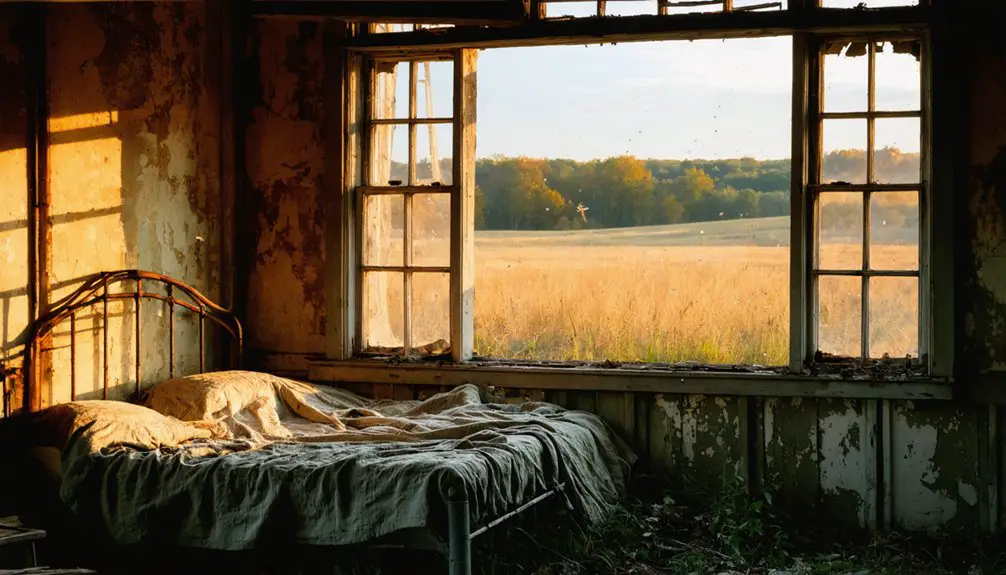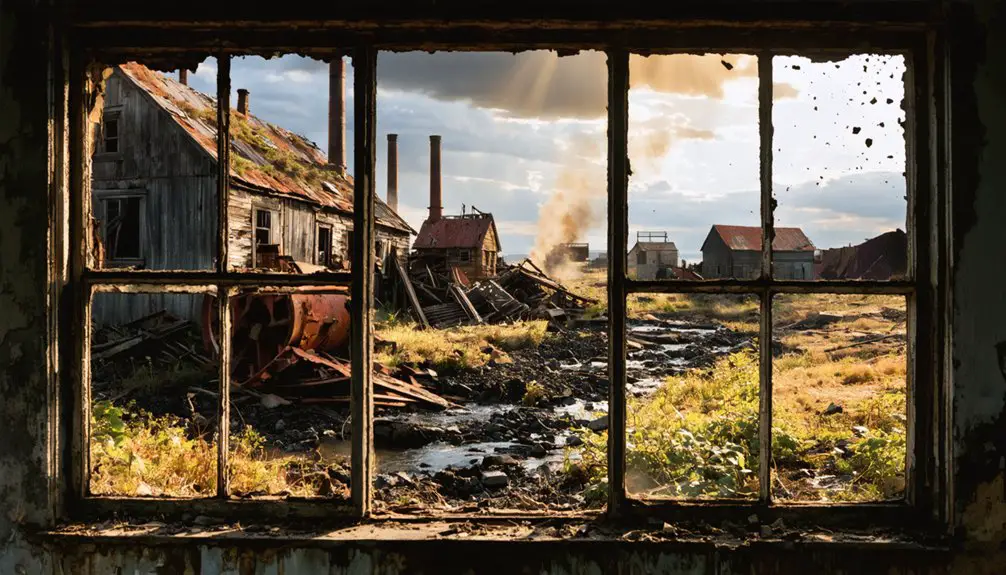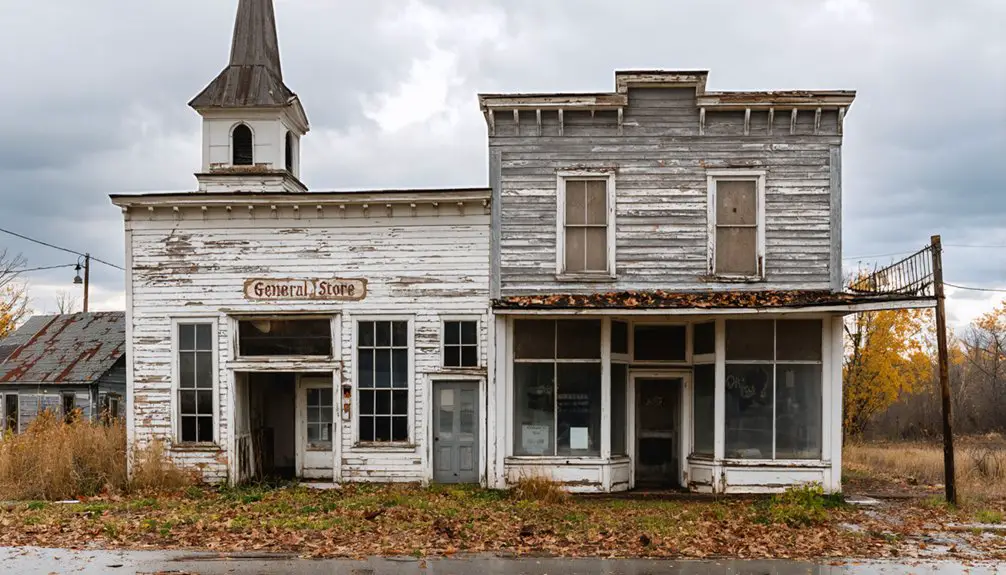You’ll find Nebraska’s ghost town in Columbia County, Pennsylvania, where it thrived as an anthracite mining community from 1856 to the mid-1900s. The town boomed after connecting to the Lehigh and Mahanoy Railroad in 1865, attracting Irish Catholic immigrants who shaped its cultural identity. At its peak, Nebraska supported 2,500 residents and 14 active mines. Today, abandoned mine shafts and crumbling foundations reveal fascinating layers of Pennsylvania’s industrial heritage.
Key Takeaways
- Nebraska was a Pennsylvania mining community that thrived during the anthracite coal boom before declining as mining operations ceased.
- The town featured coal shaft operations, defensive lookout points, and quarried stone construction used by early settlers.
- Three distinct cultural waves shaped Nebraska’s community: German-Irish Catholics, Scandinavian Lutherans, and later Hispanic and Asian immigrants.
- The Pennsylvania Railroad network was crucial for coal transport, with its abandonment contributing to Nebraska’s eventual decline.
- Local churches, company stores, and taverns served as social hubs for Nebraska’s mining families before the town’s abandonment.
The Rise and Fall of a Coal Mining Community
While many coal mining towns dotted Pennsylvania’s landscape in the 19th century, Centralia emerged as a notable anthracite mining community when its first mines, Locust Run and Coal Ridge, opened in 1856.
You’ll find the town’s growth accelerated after 1865 when the Lehigh and Mahanoy Railroad connected Centralia to larger eastern markets, transforming it into a bustling hub of coal extraction. The influx of Irish Catholic immigrants in the 1850s shaped the town’s cultural identity.
At its peak, you’d have seen 14 active mines employing workers who called this tight-knit community home, with the population reaching 2,500 residents. The town’s prosperity was fueled by its rich anthracite deposits that supported local industry for generations.
But beneath the surface of this thriving coal town, labor struggles and social tensions simmered. The violent activities of the Molly Maguires in the 1860s, including the murder of founder Alexander Rae, reflected the era’s intense labor conflicts.
Historical Timeline: 1850-1950
As Pennsylvania’s resource-rich landscape beckoned to prospectors in the 1850s, numerous towns materialized seemingly overnight across the state’s terrain.
You’d have witnessed the rapid transformation of wilderness into bustling communities, complete with abandoned infrastructure that tells the tale of boom-and-bust cycles. Similar to Pithole’s oil boom, the population could surge from zero to thousands within months. Many of these areas became coal mining towns that eventually fell into decline.
- 1850-1880: Towns exploded with populations reaching 20,000, featuring the world’s first oil pipeline, theaters, and railroads.
- 1880-1910: Peak years brought diverse immigrant populations, company housing, and coke ovens.
- 1910-1950: Economic decline set in as resources depleted, leading to mass exodus and deterioration.
Life in Nebraska’s Mining District
You’d find Nebraska’s mining districts bustling with activity as miners used matches and sulphur to test for gas while working forty-foot-deep coal shafts near rivers and valleys.
Mining communities established defensive lookout points like “Happy Jack’s Peak” while building infrastructure with locally quarried stone and chalk. Local settlers found the chalk particularly valuable as it was used in constructing building foundations for homes.
The availability of mining jobs, along with community gatherings and prospecting trips, shaped the social fabric of these settlements where newspapers actively covered mineral discoveries and scientific expeditions. The arrival of Professor Samuel Aughey and other experts led to promising coal assessments that initially sparked economic optimism in the region.
Mining Operations and Equipment
During Nebraska’s mining heyday, industrial operations centered around massive potash plants like Hord Alkali at Lakeside and American Potash at Antioch, which emerged by 1917.
You’d find state-of-the-art mining machinery innovations throughout these facilities, including Swenson evaporators, rotary dryers, and industrial grinders essential for ore processing techniques. Many of these machines were similar to those displayed at Expo during the 1898 Trans-Mississippi Exhibition.
These remarkable operations featured:
- Boiler and steam engine rooms that powered the entire facility’s machinery and electrical systems
- Massive warehouses strategically positioned near railroads for efficient material storage and shipping
- Worker housing complexes with dormitories for 100+ workers and modern staff houses equipped with electric lights and indoor plumbing
The plants’ brick, concrete, and steel construction showcased industrial advancement while ensuring fire safety in these crucial mining operations. The facilities utilized hoisting engines manufactured by the Omaha Foundry and Machine Company for their mining operations.
Early Settlement and Growth
While Spanish and French fur traders initially established scattered outposts along Nebraska’s rivers in the late 18th century, organized settlement didn’t truly begin until Fort Atkinson’s establishment in 1820 and the founding of Bellevue trading post in 1822.
You’d find early settlers streaming into the territory after the Homestead Act of 1862, building cabins and establishing essential community services. Life wasn’t easy – grasshopper plagues devastated crops, and tensions with Native Americans created ongoing challenges. Married homesteaders dominated the landscape as they could claim free land after five years of residence.
The arrival of the Burlington & Missouri and Union Pacific railroads transformed isolated settlements into thriving towns. Railroad companies owned much of the surrounding land, helping establish organized communities and county seats. Natural fuel sources were scarce until the discovery of the Honey Creek coal mine in 1906.
Early settlers built merchandise stores, blacksmith shops, churches, and schools, creating the foundation for permanent settlements that would shape Nebraska’s future.
Community Social Structure
Three distinct cultural waves shaped Nebraska’s mining communities in the late 19th century. You’d find German, Bohemian, and Irish Catholics establishing the earliest settlements, followed by Scandinavian Lutherans and German-Russian Mennonites.
By the late 1900s, Hispanic and Southeast Asian immigrants joined these communities, drawn by mining and meatpacking opportunities.
These diverse groups maintained strong community identity through:
- Religious institutions that served as social hubs and mutual aid networks
- General stores that functioned as gathering spaces for information exchange
- Cultural festivals and cooperative work events that fostered social cohesion
Despite economic challenges from seasonal mining work, you’d witness remarkable resilience as ethnic groups preserved their traditions while adapting to frontier life.
Churches and schools played essential roles in both maintaining cultural heritage and facilitating gradual assimilation into the broader community.
Notable Buildings and Architecture

Located amidst the remnants of Pennsylvania’s industrial past, a collection of concrete structures stands as a tribute to early 20th-century architectural innovation.
You’ll find abandoned architecture that tells the story of industrial heritage through its unique Nebraska Bridge, which mysteriously vanishes and reappears with changing water levels in Tionesta.
While many of Pennsylvania’s ghost towns have crumbled, Nebraska’s structures reflect the region’s resilience.
The area’s architectural legacy connects to broader patterns of industrial development, sharing similarities with other historic sites like Concrete City in Nanticoke, where concrete duplex houses defied demolition attempts.
These enduring structures, though weathered by time, continue to captivate visitors with their stark beauty and serve as silent witnesses to the area’s once-thriving industrial community.
The Mining Operations and Economic Impact
Beneath Nebraska’s architectural remnants lies a deeper story of anthracite coal mining that shaped Pennsylvania’s industrial landscape.
You’ll find that mining technology evolved as companies extracted valuable coal from seams that powered the region’s industrial boom. The town’s economy revolved around mining operations, creating economic dependencies through company-owned housing and stores.
- Local mines employed hundreds of workers, supporting families and businesses throughout the region.
- The Lehigh and Mahanoy Railroad connected Nebraska’s mines to broader markets, expanding the town’s economic reach.
- Company stores and housing created a closed economic system, where miners relied heavily on their employers for basic necessities.
Like many mining towns, Nebraska’s prosperity was tied directly to coal production, and when the mines began to decline, the town’s fate was sealed.
Workers and their families eventually left, seeking opportunities elsewhere.
Cultural Heritage and Daily Life

As Nebraska’s coal mines shaped the economic landscape, they also forged a tight-knit community centered around key institutions and daily rituals.
You’d find miners’ families gathering at the local church, which often stood as a symbol of cultural significance long after other buildings crumbled. The company store, tavern, and communal spaces became hubs where social dynamics played out through daily interactions and community events.
Like other Pennsylvania mining towns, Nebraska’s residents lived in company-owned houses clustered near the mines, creating a close but controlled environment.
Close-knit but company-controlled, Nebraska’s mining families shared identical houses, their lives revolving around the rhythms of coal extraction.
Your daily routine would’ve revolved around the mine whistle’s schedule, while leisure time meant church gatherings or tavern meetups.
Today, these heritage sites and artifacts tell the story of a community bound together by shared experiences and industrial life.
Transportation Networks and Access Routes
Three major transportation networks shaped Nebraska’s connectivity and eventual decline: the Pennsylvania Railroad’s extensive network, the region’s highways, and early canal systems.
As part of PRR’s 10,000-mile network, you’d find rail lines essential for coal and timber transport connecting through the region’s industrial corridor.
- You’ll discover abandoned PRR rights-of-way that once served as important freight routes, particularly along the Black Lick Branch’s 37-mile stretch.
- The area faced significant transportation challenges when key roadways were closed, similar to Route 61’s fate in nearby Centralia.
- You can trace the region’s early development to the West Branch Canal system of the 1830s, which first opened these remote areas to profitable resource extraction.
These transportation networks’ gradual abandonment contributed to access limitations that hastened Nebraska’s isolation and decline.
Natural Disasters and Environmental Challenges

While Nebraska’s ghost towns faced many challenges, devastating floods emerged as one of the most destructive natural forces shaping their fate.
You’ll find that flood impact was particularly severe in floodplain communities, where regulations prohibited rebuilding homes with over 50% damage. Many residents had to accept FEMA buyouts or relocate when floodwaters and mud destroyed their properties.
Environmental degradation compounded these challenges.
You’re looking at communities that struggled with groundwater contamination, threatening the drinking water supply that 85% of Nebraskans relied upon. Invasive species and noxious weeds disrupted local ecosystems, while tree loss from insect damage altered the landscape.
These environmental pressures, combined with soil contamination near industrial areas, often determined whether a settlement could sustain itself or join the ranks of Nebraska’s ghost towns.
Preservation Efforts and Historical Records
Despite the environmental challenges that threatened Nebraska’s ghost towns, dedicated preservation efforts have emerged to protect their historical legacy.
Preservation Pennsylvania leads initiatives by partnering with local advocates to implement preservation strategies and secure funding for at-risk structures. You’ll find extensive archival documentation maintained through trail guides, operational histories, and community-contributed records.
- Expert consultations assess structural conditions to inform preservation and adaptive reuse plans
- Historical societies consolidate mining contracts, labor records, and genealogical information
- The Ghost Town Trail initiative coordinates local governments and community groups to maintain historical corridors
Through these preservation efforts, you’re able to explore stabilized structures while interactive materials and interpretive programs help you connect with the region’s rich mining heritage.
Ghost Town Tourism and Visitor Information
Today’s ghost town tourism in Pennsylvania draws visitors from across the region, with notable concentrations from Cambria County (38.5%) and Indiana County (26.8%).
You’ll find the Ghost Town Trail stretches 36 miles with multiple trailheads, perfect for hiking and biking adventures through these historic locations.
While exploring Pennsylvania’s ghost towns, you can expect to spend part of your estimated $1.7 million in annual visitor expenditures on local accommodations and amenities.
The tourism helps sustain communities along these routes through hospitality spending. For a unique experience, you might consider visiting Centralia, though access is now limited due to safety concerns.
While the famous Graffiti Highway is closed, you can still legally explore nearby areas, including family grave sites and participate in regional cultural events that showcase the area’s coal mining heritage.
Frequently Asked Questions
Were Any Famous Outlaws or Criminals Known to Operate in Nebraska?
You’ll find outlaw legends like Doc Middleton stealing thousands of horses, Jesse James seeking refuge, and other criminals thriving along Nebraska’s Outlaw Trail, where sparse law enforcement couldn’t catch them.
What Happened to the Mining Equipment After the Town Was Abandoned?
You’ll find most mining equipment was either salvaged by scrap dealers, recycled for metal value, or left to rust where it stood when miners abandoned this ghost town’s operations.
Did Any Major Epidemics Contribute to the Town’s Population Decline?
You won’t find epidemics as a major cause of population decline in these towns. Historical records show economic factors, resource depletion, and environmental hazards like mine fires drove people away.
Were There Any Documented Paranormal Activities in Nebraska’s Abandoned Buildings?
You’ll find documented ghost sightings at Seven Sisters Road, Museum of Shadows in Plattsmouth, and Mystery Manor in Omaha. These haunted locations feature apparitions, unexplained noises, and mysterious physical encounters.
What Native American Tribes Originally Inhabited the Area Before Nebraska’s Establishment?
You’ll find rich tribal history in Nebraska’s original inhabitants: the Pawnee, Arikara, Omaha, Ponca, and Oto tribes settled along rivers, while Lakota, Arapaho, and Cheyenne maintained cultural heritage through nomadic lifestyles.
References
- https://history.nebraska.gov/wp-content/uploads/2017/12/doc_publications_NH1937GhostTowns.pdf
- https://negenweb.us/knox/stories/ghosttowns.htm
- https://llcgs.info/cpage.php?pt=54
- https://www.youtube.com/watch?v=l3s2qhSxis8
- https://freepages.history.rootsweb.com/~gtusa/usa/ne.htm
- https://pabucketlist.com/the-rise-and-fall-of-centralia-pas-toxic-ghost-town/
- https://www.youtube.com/watch?v=Qj5LjacccJ0
- https://en.wikipedia.org/wiki/List_of_ghost_towns_in_Pennsylvania
- https://allthatsinteresting.com/centralia-pa
- https://en.wikipedia.org/wiki/Centralia



